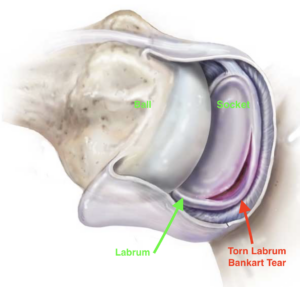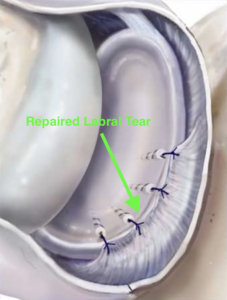Surgery for the Dislocating Shoulder/ Bankart Repair Surgery
Your Diagnosis
A Bankart repair surgery is done for a person who has a dislocation shoulder. See the Shoulder Dislocations section.
What happens during Surgery?
During surgery the torn labrum is repaired back down to the cup of the shoulder. Usually this is accomplished using suture anchors.
This surgery can be done either through the arthroscopically or by open surgery. Both have advantages. Arthroscopic repair has the advantage of being less painful right after surgery, but the chances of the shoulder dislocating again are higher than open surgery. Open surgery has the advantage of having a higher success rate, but is more painful immediately after surgery. Both surgeries have the same recovery time and use the same therapy program.
Surgery takes between 45 minutes to 1 hour. It is done with general anesthesia meaning the person is asleep. Usually the person will have a nerve block placed in their neck which makes their shoulder and arm numb for 6 to 24 hours.
Immediately after Surgery
The person will wake up from surgery in the recovery room. The person may notice they cannot feel or move their arm, hand and fingers. This is because of the nerve block and is normal.
After spending 1 to 3 hours in the recovery room the person will be allowed to either go home or be moved up to their room. If they go home, they will need a ride, as they cannot drive or take public transportation. If they stay in the hospital overnight, they will be in a bed with a special continuous range-of-motion machine (CPM). The nurse will hook the person up to the machine and teach the person how to use the machine. This machine should be used as often as possible.
A person may have questions following your surgery. Many of these frequently asked questions about surgery can be answered here.
What to expect after Surgery: Week 0 through Week 6 (Phase One)
- Pain: It is normal for a person to experience moderate to severe pain for the first few days after surgery. A person will be given pain pills to take for the first 5 days after surgery. After that, only Tylenol is recommended (only if the person’s primary doctor says it is safe for them). Pain from the surgery should decrease by roughly half with each passing day. If done correctly and often, the stretching usually decreases the pain. If a person wakes up with pain in the middle of the night, they should do their stretching exercises to decrease the pain.
- Therapy: After waking up from surgery and being brought up to their room, a therapist will visit the person to teach the person the 0/90 Program. This therapy program involves stretching the shoulder that had the surgery with the help of the other arm. The person will be taught 2 stretches. Each stretch must be done 5 times in a row. Each set must be done 5 times a day. This means that the person must do a minimum of 50 stretches per day.
- If a person’s shoulder is too sore to be stretched, it’s very important that they communicate this to their doctor and/or therapist. Every day that passes that a person does not achieve their range-of-motion goals, makes it extra difficult to get back on track.
- Precautions: For the first 6 weeks after surgery, a person may do Passive Range-of-Motion only. It is extremely important the person does not actively use their arm (Active Range-of-Motion), and keep it completely relaxed for the first 6 weeks after surgery. The reason for this is that the repair needs time to heal. If a person actively uses their shoulder before this repair is fully healed, the surgical repair could pull apart, and the person may need another surgery.
- Although a person will not be permitted to move their arm/shoulder away from their body, they will still be able to move their elbows and wrists. This means they can still do easy things like type, write, cut their food, feed themselves, wash their face, etc.
- The only form of exercise that a person should do at this point, is: 1) walk uphill on a paved, even road with their arm in a sling or 2) ride a stationary bike with their arm in a sling and not holding on to the handle bar.
- Work: Nothing should get in the way of the shoulder stretches after surgery. If a person wants to go back to work right away then a doctor’s note will be given stating that they must be allowed time to do the stretches needed. If the person would like to stay off work then they will be given a doctor’s note.
What to expect after Surgery: Week 6 through Week 12 (Phase Two)
- Pain: It is expected that there will be pain with movement of the shoulder. Pain should be much less than the first few weeks after surgery. Most people are comfortable if they are resting.
- Therapy: Starting on week 6 new stretches will be started. The person will begin 4 Quadrant Stretching. They will also begin the Early Strengthening Program.
- Precautions: Starting on week 6 most precautions are lifted. The person may begin to use their arm. The level of activity will be guided by their pain. If the pain is tolerable then they can continue their activity. If the pain is too much then they should back off the activity.
The shoulder and arm will be weak at this point since the person has not used the arm for the last 6 weeks. As such the person should use common sense when returning to activities. For example, if the person wants to play golf then start out at the driving range first to see how the shoulder responds -they should not jump into 18 holes with their friends. Or, if the person wants to swim, then they should start out in the shallow end to see how the arm will respond -not the deep end. - At this point the person should not engage in any activities that “test” their shoulder. They should avoid activities with a high likelihood of trauma such as contact sports or skateboarding.
- Work: Work should not interfere with the therapy programs. If a person wants to return to work during this period they must find time to stretch and strengthen.
Most people who have jobs that require physical labor are not ready to return to work at the 6 week mark. Some may be ready to go back around week 8-10. It’s unlikely that a person who has a highly physical job will go back to full duty at this time. A doctor’s note will be given when needed.
What to expect after Surgery: Week 12 through 1 year and beyond (Phase Three)
- Pain: The pain will continue to decrease over the year. It is normal to still have pain once in a while.
- Therapy: After week 12 most people will begin to decrease the number of stretches and strengthening exercises they do. They also can begin to return to normal activities. Their function will gradually improve over the year.
- Precautions: Usually by the 12 week mark, a person is doing about 80% of the kind of activity and exercise they were doing prior to surgery. It is important to note, most people continue to improve for at least 1 to 1 1/2 years after their surgery.
- Work: Most people have returned to work.
Returning back to Sports
A person is likely to be given approval to return back to sports somewhere between the 4 month to 1 year mark. This large time frame is due to the large differences between individuals and athletes. The rule of thumb is that a person must be as strong and as flexible on their surgical side as they are to their other side. They must also be as strong and as flexible on their surgical side as they were before their injury. Basically, they must be certain they feel 100%. If a person returns to sports before they are certain they feel 100%, they are at an increased risk of dislocating their shoulder again.

